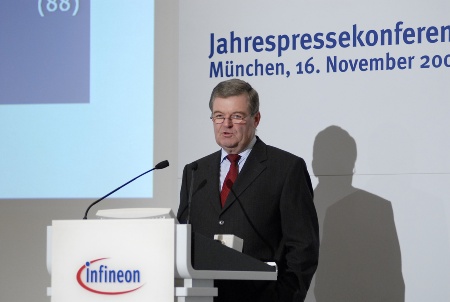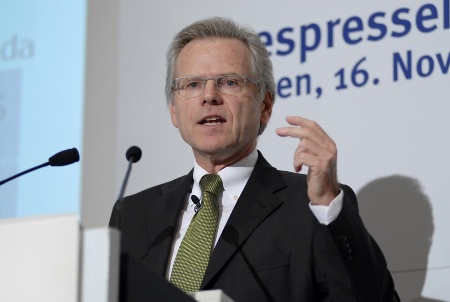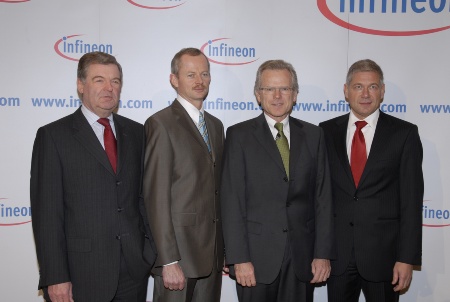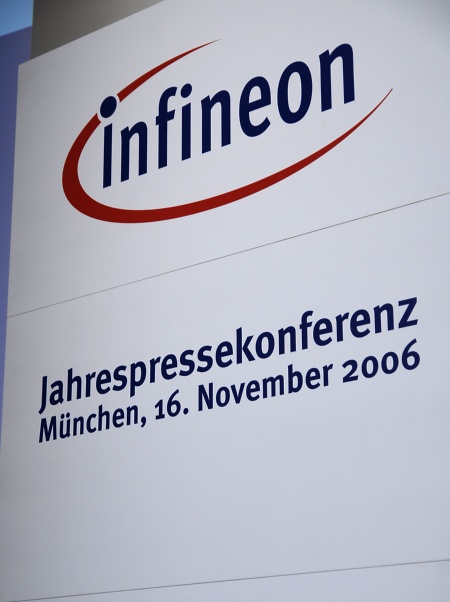Infineon Specifies Medium-term Objectives: "10% Growth and 10% Ebit. Focus on Energy, Mobility and Safety/Security"
Downloads available / Please see below
Munich, November 16, 2006 - Dr. Wolfgang Ziebart, President and CEO of Infineon, specified the company's medium-term objectives at the annual press conference held in Munich on November 16, 2006. The major restructuring measures are expected to be completed in 2007. The new Infineon, after carving out memory company Qimonda, will concentrate on three main fields of activity in the future: energy efficiency, mobility and connectivity, as well as safety and security. Ziebart summarized the medium-term goals under the heading of "Focus on 10".
"In the medium term, we want to grow by at least 10% annually and we want to achieve an annually EBIT margin of at least 10%," said Ziebart. "From today's standpoint, these are ambitious goals. But we are convinced that we will be able to reach them." Regarding the recently started fiscal year 2006/2007 Ziebart announced: “In 2007, we will have completed the major restructuring work in the company and will leave the operational loss phase behind. Once these measures have been completed, we will have the basis for a sustainable growth strategy and profitability. As a result, we will concentrate our efforts on moving all our business units into the profit zone by the fourth quarter of this financial year at the very latest," Ziebart continued at the annual press conference. "For Wireless Communications, we hold to the statement that we aim to reach the break-even point in the fourth quarter of the calendar year."
“New Infineon"
The "new" Infineon – following the carve-out of Qimonda – is now a company with sales of more than Euro 4 billion and with more than 29,000 employees, 6,000 of whom work in the field of research and development alone. Infineon invests approximately Euro 800 million a year in research and development. More than 22,800 patents are convincing proof of the company's technological leadership.
Infineon is active on a market that is expected to grow at an average of 10 percent annually over the next few years. Accroding to Ziebart, the "new" company will focus on three main areas of activity that reflect three central challenges to modern society: energy efficiency, mobility and connectivity, as well as safety and security.
The company is already making significant contributions to these markets and has established good starting positions. Plans have been made to continue to expand these strengths and to consistently take advantage of all opportunities for future growth.
Infineon products provide for the enhanced
energy efficiency of engines, drives and electronic devices. The company's semiconductors are already the basis for efficient energy management in power supplies for PCs or drive controls for electric motors in washing machines, industrial systems and trains. Its components primarily help private households, where most of the energy is consumed, to reduce power needs in refrigerators, air conditioners and electric stoves and ovens. Wind-energy and solar systems, fossil-fuel plants and transformer stations also use semiconductors from Infineon.
Chips from Infineon are used for
mobility and connectivity to provide location-independent access to information, whether from cell phones, using broadband Internet access or wireless applications. Thanks to modern communications technology, people are now closer together; geographical distance no longer plays a role. Personal accessibility and the simultaneous availability of information should be made possible anywhere at any time. Infineon's wireless and wireline access technologies for voice and data communication play a very critical role here.
In the field of
safety and security, semiconductors from Infineon provide for data security and personal safety, in road traffic, for example. Security requirements in the private sector, as well as in public offices, are increasing in the same way as for the protection of privacy and of material and intellectual property. Key words here include passports, ID cards, and health cards. Customer-specific chips are also equipped with security functions, like those used by Microsoft in its gaming consoles.
On a majority of these markets, Infineon is already in a good position and moving forward successfully: power semiconductors, chip-card ICs, access products for broadband communication and RF solutions for cell phones. Infineon has already been an international market leader in these fields for years. On the market for semiconductors in the automotive industry, Infineon saw growth in 2005 that was significantly stronger than the market average and was able to further expand its Number 2 position on the market worldwide. In Europe, Infineon is still the undisputed Number 1.
"It is our goal to reach the Number 3 position at the very least in all our activities in these market segments," continued Ziebart. "The revenues from the sale of the Qimonda shares will help us in this endeavor to grow. We plan to use these revenues, among other things, to make acquisitions to win new customers and tap into markets where we are not currently represented with adequate presence. Our acquisition strategy will also reflect our focus on existing strengths. But first and foremost, we want to grow on our own strength. Our strengths form the basis for future growth - for profitable growth."
In this regard, Ziebart plans to align the company's activities even more closely with customer requirements. Contrary to previous activities, Infineon will orient its roadmaps more strictly towards its customers' specific needs and not towards an anonymous end-customer market. In addition, the complexity of the company will be reduced further. The Infineon Complexity Reduction Program (ICoRe) aims to make task and process structures in the company more efficient. The corresponding measures are already being implemented in the current fiscal year. The company expects these measures to result in savings amounting to at least EUR 50 million
.
Infineon will also continue to consistently promote its new production and development strategy. “In the medium-term, investments will be reduced to approximately 10 to 12% of total revenues”, Ziebart said. Within the scope of this strategy, the company will also pursue different approaches for the individual fields in the logics business. Infineon will no longer invest in its own capacities for components with structures of 65 nanometers and below, most of which are produced in standard CMOS technology, but will develop and produce these components with competent partners. Infineon will take a different approach for power semiconductors. Since the production technology used and the quality achieved in the production of power semiconductors plays a major role in the competitive arena, the company will keep process development as well as production completely under its own control. "This "fab-light" approach has two major advantages: We can considerably reduce our investment expenditures while ensuring the competitive edge of our production landscape at the same time," Ziebart stated.
Financial year 2005/06
“Infineon reached a number of very important milestones in the past financial year”, Ziebart stated. One very important milestone was the carve-out and IPO of the memory business. Infineon and Qimonda are two highly focused companies with clearly defined strategies and clear prospects for their respective customers, employees and investors.
Additionally, the company was successful in significantly reducing the number of losing segments in its core business, i.e. in the Automotive, Industrial & Multimarket segment as well as in the Communication Solutions segment. During the past financial year, the company was able to bring the businesses in discretes, tuners, RF power transistors and the chip-card ICs from years in the red back into a turn-around, the latter even one quarter earlier than originally planned. Thanks to the restructuring of these activities, the company has made a sales volume of EUR 700 million in total once again profitable.
Information Number
INFXX200611.021
Press Photos
-

-

-
 Peter Fischl, Peter Bauer, Dr. Wolfgang Ziebart, Prof. Dr. Hermann Eul (from left to right)ifx_jpk_2006_02.jpg
Peter Fischl, Peter Bauer, Dr. Wolfgang Ziebart, Prof. Dr. Hermann Eul (from left to right)ifx_jpk_2006_02.jpgJPG | 2.5 mb | 2896 x 1944 px
-
 Annual Press Conference 2006 / Jahrespressekonferenz 2006ifx_jpk_2006_01.jpg
Annual Press Conference 2006 / Jahrespressekonferenz 2006ifx_jpk_2006_01.jpgJPG | 2.63 mb | 1940 x 2596 px
